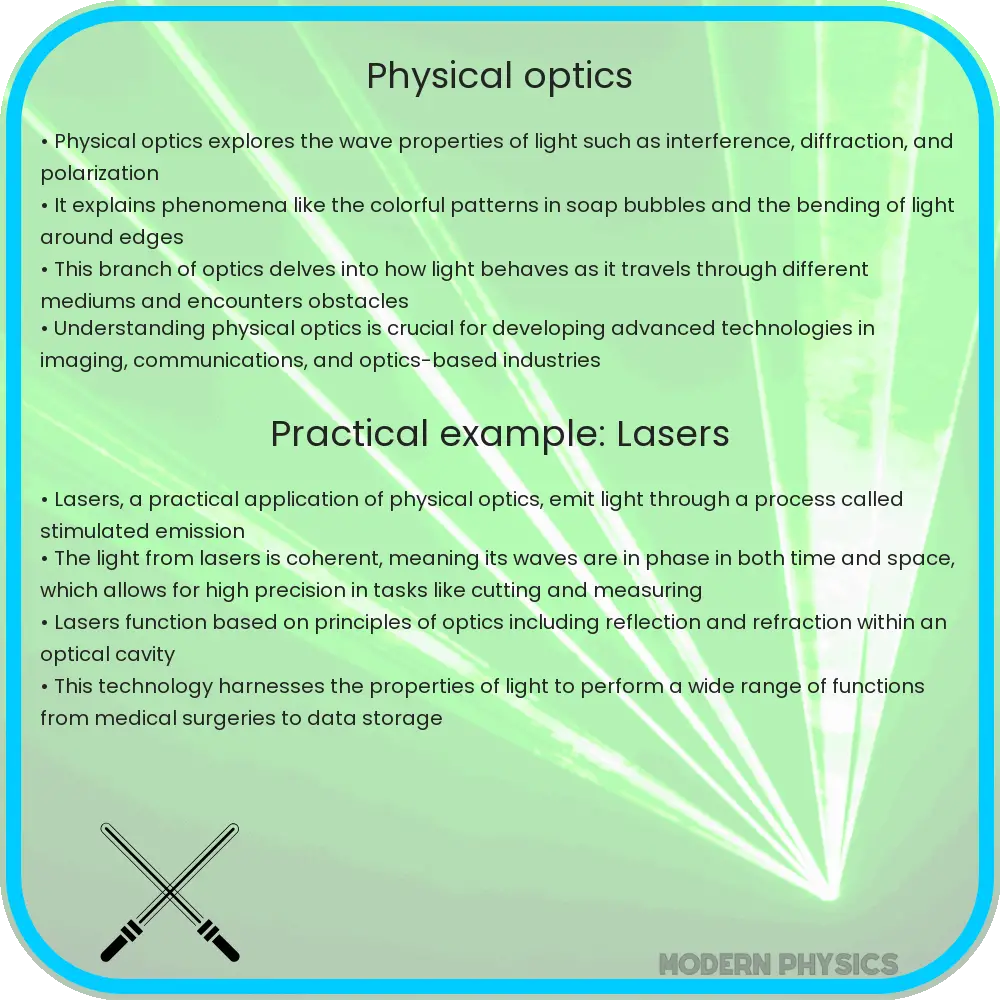Explore the wave theory of light in physical optics, understanding phenomena like diffraction, interference, and its applications in technology.

Understanding Physical Optics: Wave Theory and Its Implications
Physical optics, an essential branch of optics, delves into the nature of light and its interaction with matter, emphasizing its wave-like properties. This approach contrasts with geometric optics, which approximates light as rays to explain reflection and refraction but falls short when addressing phenomena like diffraction, interference, and polarization. By embracing the wave theory of light, physical optics offers a more comprehensive understanding of these complex phenomena, paving the way for various technological advancements and applications.
Wave Theory of Light
The wave theory of light, initially proposed by Christian Huygens in the 17th century, posits that light consists of waves rather than particles. This theory gained substantial support through Thomas Young’s double-slit experiment, which demonstrated light’s interference patterns, a hallmark of wave behavior. The wave theory explains that light waves, similar to water or sound waves, can interfere with each other, leading to constructive (amplification) or destructive (diminution) interference, depending on their phase relationship.
Key Phenomena Explained by Wave Theory
- Diffraction: This phenomenon occurs when a wave encounters an obstacle or slit that is comparable in size to its wavelength, causing it to bend around the edges. Diffraction is fundamental in understanding the resolution limits of optical instruments, such as microscopes and telescopes.
- Interference: When two or more light waves overlap, they can either strengthen or weaken each other, leading to patterns of bright and dark bands. This principle is exploited in various optical instruments and technologies, including anti-reflective coatings and holography.
- Polarization: Unlike waves that oscillate in multiple planes, polarized light waves oscillate in a single plane. Polarization is critical in areas like photography, LCD technology, and the study of atmospheric and underwater light scattering.
Applications and Techniques in Physical Optics
Physical optics is not just a theoretical framework; it has practical applications across multiple fields. From the design of optical fibers that transmit data over vast distances to the development of laser technology used in surgery, manufacturing, and communication, the principles of wave theory are foundational. Techniques such as holography, which uses interference patterns to create three-dimensional images, and optical coherence tomography, a medical imaging technique, underscore the versatility and impact of physical optics in modern technology.
Is this conversation helpful so far?
Advanced Techniques in Physical Optics
Further exploration into physical optics reveals sophisticated techniques that leverage the wave nature of light for innovative applications. Fourier optics, for instance, applies mathematical Fourier transforms to understand and manipulate the light field, crucial in image processing and pattern recognition. Similarly, quantum optics merges the principles of quantum mechanics with optics to study the quantum nature of light, leading to breakthroughs in secure communication through quantum cryptography and the development of quantum computers.
Challenges and Future Directions
Despite its significant advancements, physical optics continues to face challenges, especially in pushing the limits of resolution and speed in optical systems. Overcoming these barriers often requires novel materials and technologies, such as metamaterials that can bend light in unusual ways to achieve invisibility cloaks or superlenses that surpass the diffraction limit. Additionally, the integration of nanotechnology and optics promises even more compact and efficient devices, opening new frontiers in photonics and biomedical imaging.
Conclusion
The realm of physical optics, grounded in wave theory, is a testament to the profound impact of understanding light’s wave-like behavior on technological progress and scientific knowledge. From elucidating fundamental phenomena like diffraction, interference, and polarization to fostering innovations in communication, imaging, and computing, physical optics bridges the gap between abstract theory and practical application. As researchers continue to unravel the complexities of light and its interactions with matter, the future of physical optics shines brightly, promising advancements that we can scarcely imagine today. This ever-evolving field not only enriches our understanding of the natural world but also enhances our ability to harness the power of light, driving forward the boundaries of science and technology.
